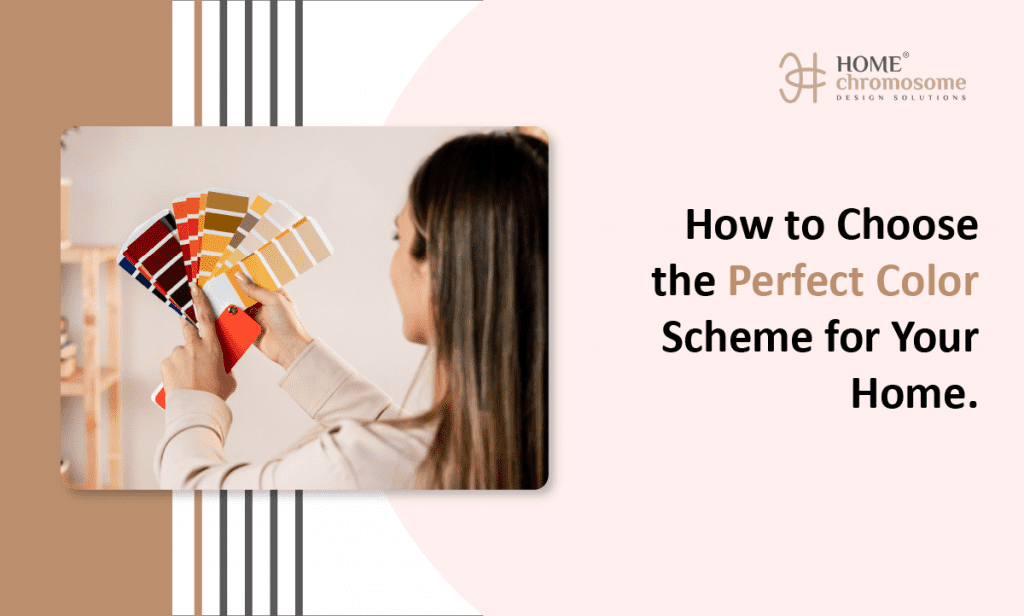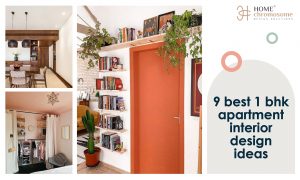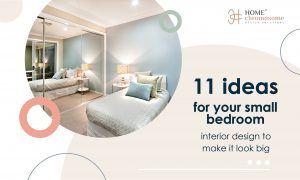
Choosing the ideal colour scheme for your home is more than just selecting your favourite colours; it’s about creating a cohesive look that enhances the space and reflects your style. Whether you’re redecorating a single room or your entire home, a suitable colour scheme can make a big difference. Before trying to find the perfect scheme for home décor, we will try to understand colour psychology in home decor.
Understanding Colour Psychology in Home Decor
Colour psychology is crucial in interior design, affecting our mood and behaviour in different spaces. Colour can evoke specific feelings and reactions, making the choice of colour scheme in home décor not just a matter of aesthetic preference but also a tool for creating a desired atmosphere.
Warm colours like red, orange, and yellow evoke warmth and energy, making them ideal for social spaces like the living room and kitchen. On the other hand, cool colours such as blue, green, and purple offer a calming effect, perfect for bedrooms and bathrooms. When choosing your colour scheme for your home decor, consider the psychological impact of colours to create the desired atmosphere.
When applying colour psychology to home décor, consider the function of each room and the mood you wish to create. For instance, bedrooms benefit from calming colours like soft blues and greens, promoting relaxation and restful sleep. On the other hand, living rooms and kitchens can handle more vibrant colours like yellows and oranges, which foster social interaction and vitality.
Another aspect to consider is the association with specific colours, as individual experiences can influence how a colour affects mood. Personal preference should guide the final decision in home decor, ensuring the space reflects the inhabitants’ personalities.
Now that we’ve covered the basics of colour usage let’s look at how to navigate the sea of colours to achieve the desired effect.
Start with the Ceiling: The Fifth Wall
Did you know your ceiling can be crucial to how spacious your home feels? If you’re dealing with low ceilings, try painting them the same colour as your walls. This trick blurs the lines between where your walls end and your ceiling begins, making your rooms feel taller and more open. Opt for lighter shades or whites to maximize this effect. Conversely, if you’re feeling adventurous, selecting a ceiling colour slightly lighter than your wall colour can also create the illusion of height. For instance, pairing cream walls with a soft white ceiling can open up your space beautifully.
Choose Your Base Colour: Setting the Tone
Your base colour sets the tone for your entire home. Think about the mood you want to evoke. Cozy and inviting? Calm and serene? Vibrant and energetic? Your base colour will guide the rest of your home decor ideas, so choose wisely. If you’re unsure where to start, consider neutral tones like beige, gray, or soft blues and greens. These colours create a versatile backdrop for easy updates with home accessories and furnishings.
Add Depth with Secondary Colours
Once you’ve chosen your base colour, it’s time to add depth and interest with secondary colours. These are usually a shade or two darker or lighter than your base colour and are used in smaller proportions. For example, if your base colour is a light grey, a darker charcoal or a soft lavender can serve as great secondary colours. They help break up the monotony and add visual interest to your home décor.
Accent Colours: The Spice of Home Décor
Accent colours are where you can express your personality. These are the colours you use sparingly, in home accessories like cushions, art pieces, or a feature wall. They should complement your base and secondary colours but stand out enough to make a statement. Remember, a little goes a long way with accent colours.
Test Your Colours: The Importance of Samples
Before committing to your chosen palette, test your colours in the intended space. Paint samples on large pieces of paper or directly on the walls to see how the colours look at different times of the day and under various lighting conditions. This step can save you from disappointment in home decor and ensure you’re delighted with your final choice.
Balancing Trends and Timelessness
While it’s tempting to go all-in with the latest colour trends, remember that your home décor should stand the test of time. Use trendy colours as accents rather than the base of your colour scheme. This way, you can easily update your space without a complete overhaul when trends change.
Home décor is all about your style and creating beautiful and functional spaces. Whether you’re starting from scratch or looking to refresh your existing décor, the world of interior design is entirely of decorating ideas to inspire your projects. Here’s a comprehensive look at some timeless and contemporary home decor ideas.
Incorporating Home Accessories
Once you’ve selected your primary colour palette, consider how home accessories and textiles can complement and enhance your colour scheme. Home accessories play a pivotal role in home decor, transforming spaces from mere rooms into personal style and taste reflections. Often considered the finishing touches in home decor, these elements bring colour, texture, and personality to a home. Let’s delve into the various types of home accessories in home décor and how they contribute to interior spaces’ overall aesthetic and functionality.
Artwork
Artwork is one of the most expressive home accessories, offering an immediate way to inject personality into a space. Whether it’s a large-scale painting that serves as a focal point in a living room or a series of small prints in a hallway, art pieces reflect personal taste and can evoke emotion, provoke thought, or simply add beauty to a room. The frames’ selection, arrangement, and positioning can significantly impact a room’s ambiance and style.
Throw Pillows and Blankets
Throw pillows and blankets add layers, texture, and colour to a living space. They can easily be swapped out according to season or trend, making them versatile tools in the interior designer’s toolkit. Pillows can be mixed and matched in various colours, patterns, and textures to complement or contrast with the room’s existing decor. At the same time, blankets offer both warmth and an opportunity to introduce a soft, tactile element to sofas, chairs, and beds.
Lighting Fixtures
Lighting fixtures are not just functional necessities but also vital decorative elements. A statement chandelier, a sleek floor lamp, or industrial-style pendants can dramatically alter a room’s mood and aesthetic. Lighting can highlight architectural features, artwork, or specific areas within a room, creating ambiance and adding depth to the space.
Rugs and Carpets
Rugs and carpets serve multiple purposes in interior design: they define areas within larger spaces, add warmth and comfort underfoot, and introduce colour and pattern to a room’s palette. A rug’s size, shape, texture, and pattern can significantly influence the room’s overall appearance and feel, making it a powerful home decor tool.
Decorative Objects and Collectibles
Decorative objects, such as vases, sculptures, and collectibles, add character and interest to interior spaces. These items can tell a story, evoke memories, or simply add a touch of beauty to a room. Grouping smaller items can create a curated look, while larger pieces might stand alone as focal points.
Mirrors
Mirrors are a designer’s secret weapon for making spaces appear larger and brighter. By reflecting light, mirrors enhance the natural brightness of a room and can make small spaces feel more expansive. Beyond their functional benefits, mirrors come in a wide range of styles and frames, adding an aesthetic element to walls or serving as statement pieces in their own right.
Plants and Greenery
Plants bring life, colour, and texture to interior spaces, contributing to a home’s overall well-being and comfort. Beyond their aesthetic appeal, plants can improve indoor air quality and bring a sense of nature indoors. From large potted plants that anchor a corner to small succulents on a shelf, greenery is a versatile accessory that suits any design style.
Books
Books are not only for reading; they’re also excellent decorative accessories. A well-styled bookshelf can serve as a focal point in a room, while artfully placed stacks of books on coffee tables or side tables add a lived-in, cozy feel. Books offer visual and intellectual interest, making them indispensable in home decor.
Incorporating home accessories into interior design is an art that balances form and function. These elements are crucial for creating spaces that are not only visually appealing but also reflective of the inhabitants’ personalities and lifestyles. By carefully selecting and arranging home accessories, designers and homeowners alike can craft unique, inviting, and genuinely personal interiors.
Final Thoughts
Choosing the perfect colour scheme for your home is a personal journey. It’s about finding the right balance between what’s trendy and what feels suitable for you. Your home reflects your personality, so let your colour choices speak to who you are. With these tips in mind, you’re well on your way to creating a space that feels uniquely yours.







